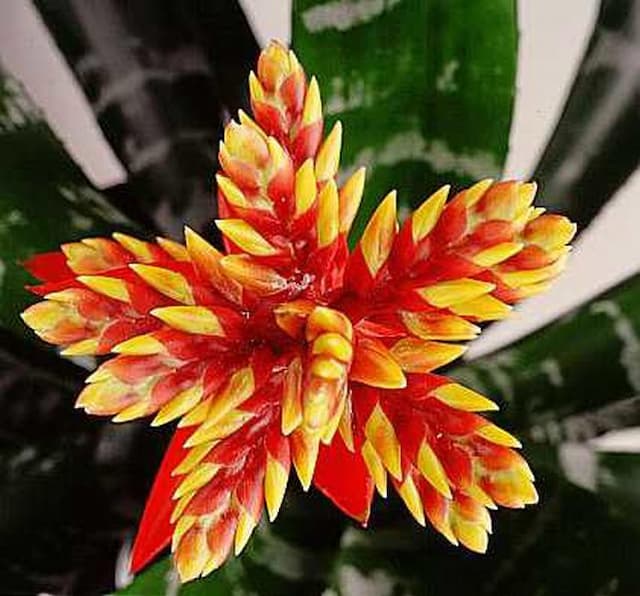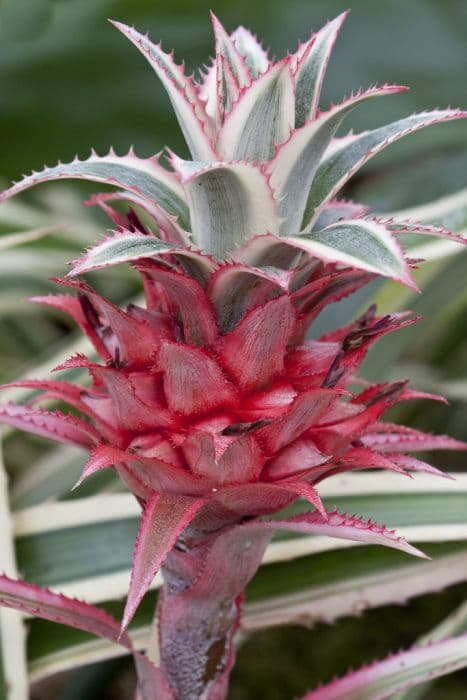Air Plant Tillandsia stricta

ABOUT
Tillandsia stricta, commonly known as air plant, has a unique and striking appearance, well-suited to its epiphytic lifestyle, meaning it often grows on other plants or surfaces rather than in soil. This plant boasts a rosette of narrow, stiff leaves that are typically green, silver, or grayish due to the presence of tiny scales on the surface, which help it absorb moisture and nutrients from the air. The leaves tend to grow in an upward fashion, creating a somewhat tubular or funnel-like shape that converges at the plant's base. Depending on the variety, the foliage can have a smooth or slightly scaly texture, and may appear shiny or matte. The edges of the leaves are usually smooth with no serration. One of the most charming features of the air plant is its bloom. The flowers emerge from the center of the rosette on a slender, erect stem. The blossoms display vibrant colors, commonly showing hues of pink, red, purple, or blue that contrast beautifully against the foliage. Moreover, the flowers can have a tubular or spiky shape, which adds an exotic touch to the plant's overall appearance. In terms of its life strategy, the air plant has a clumping habit, often producing new growths or pups from the base after the flowering cycle, gradually forming a larger cluster over time. These pups can be left to form a natural clump or can be separated to grow as individual plants. Overall, the air plant presents a stylish and modern look, ideal for contemporary decor, and its distinctive shape and method of nutrient absorption make it a fascinating specimen among houseplants. Its versatility in placement, not needing soil, allows it to be displayed in a variety of creative ways, such as in glass terrariums, mounted on pieces of wood, or simply placed atop a shelf, bringing a touch of nature's ingenuity into indoor spaces.
About this plant
 Names
NamesFamily
Bromeliaceae.
Synonyms
Air Plant, Strict Tillandsia, Upright Air Plant.
Common names
Tillandsia stricta Sol. Ex Ker Gawl.
 Toxicity
ToxicityTo humans
Tillandsia stricta, commonly known as air plant, is not known to be toxic to humans. Ingesting any part of this plant is unlikely to cause poisoning or adverse health effects.
To pets
Tillandsia stricta, or air plant, is generally considered non-toxic to pets. There should be no symptoms of poisoning if a pet ingests parts of this plant, as it is not known to contain any substances harmful to animals.
 Characteristics
CharacteristicsLife cycle
Perennials
Foliage type
Evergreen
Color of leaves
Varies
Flower color
Varies
Height
6-8 inches (15-20 cm)
Spread
6-8 inches (15-20 cm)
Plant type
Bromeliad
Hardiness zones
9
Native area
South America
Benefits
 General Benefits
General Benefits- Low Maintenance: As an epiphytic plant, Tillandsia stricta requires minimal care, adapting to a wide range of environments and thriving with simple watering and occasional feeding.
- Visual Appeal: With its striking silver-green leaves and vibrant blooms, it adds aesthetic interest to any space, serving as a living piece of decor.
- Easy to Propagate: Tillandsia stricta can reproduce through offsets or "pups," making it easy for enthusiasts to expand their collection or share with friends.
- Space Efficiency: Being small and adaptable, it's ideal for those with limited space, allowing for creative displays such as mounted on walls or placed in terrariums.
- Indoor Adaptability: It is well-suited for indoor environments, thriving under a variety of light conditions, and tolerating the typically dry air of heated and air-conditioned spaces.
- Stress Reduction: Having plants around has been shown to reduce stress, and this air plant, with its gentle structure and calming presence, can contribute to a more relaxing environment.
 Medical Properties
Medical Properties- This plant is not used for medical purposes.
 Air-purifying Qualities
Air-purifying QualitiesThis plant is not specifically known for air purifying qualities.
 Other Uses
Other Uses- Artistic Displays: Tillandsia stricta can be incorporated into living art pieces, such as green walls or moss art, adding texture and a touch of nature to interior designs.
- Wedding Bouquets: This plant can be used in non-traditional wedding bouquets, providing a unique and modern floral element that requires no water during the event.
- Jewelry: Small Tillandsia stricta plants can be fashioned into living jewelry, such as pendants or brooches, for an organic and eco-friendly accessory.
- Biodegradable Holiday Decor: They can be used as biodegradable holiday ornaments that won't contribute to plastic waste and can be composted after use.
- Educational Tools: These plants can serve as a hands-on educational tool to teach children about botany and the life cycle of epiphytes.
- Therapeutic Crafts: Creating arrangements with Tillandsia stricta can be a relaxing activity, often used in therapeutic horticulture programs to reduce stress and improve mental well-being.
- Feng Shui Enhancements: The use of Tillandsia stricta can contribute to the feng shui of an environment, purportedly bringing positive energy and balance to a space.
- Film and Theatrical Set Design: They are used to create realistic flora in film, television, and theater productions, especially for scenes requiring exotic or alien-looking plants.
- Corporate Gifting: As a low-maintenance plant, Tillandsia stricta is a popular choice for corporate or event gifting, symbolizing growth and sustainability.
- Delicate Sound Absorbers: When used in large numbers, these plants can contribute to the reduction of ambient noise in a room, making for a quieter and more peaceful environment.
Interesting Facts
 Feng Shui
Feng ShuiThe air plant, which is the common name for Tillandsia stricta, is known for its ability to improve air quality and thus can be used in Feng Shui to promote the flow of positive energy, especially in areas of the home associated with health and well-being. According to Feng Shui, placing an air plant in the east sector of a space will enhance family harmony and health, while positioning it in the southeast can bolster wealth and abundance.
 Zodiac Sign Compitability
Zodiac Sign CompitabilityThe air plant is not used in astrology practice.
 Plant Symbolism
Plant Symbolism- Independence and Freedom: As an air plant, Tillandsia stricta absorbs nutrients and water from the air through its leaves, symbolizing an adaptable and independent nature, free from requiring soil to grow.
- Resilience and Tenacity: This plant's ability to latch onto various surfaces and thrive under a variety of conditions represents resilience and the tenacity to survive against the odds.
- Persistence: Their slow growth and long life cycle reflect a message of persistence and longevity in endeavors or relationships.
- Uniqueness: The unique appearance and growing habits of the air plant signify embracing one’s uniqueness and standing out in a crowd.
- Love and Affection: The bright blooming flowers of Tillandsia stricta can symbolize love, warmth, and affection, making them popular gifts between loved ones.
 Water
WaterThe Air Plant (Tillandsia stricta) thrives when misted 2-3 times a week with a mister, ensuring that water reaches the center of the plant without becoming waterlogged. For a thorough watering, submerge the plant in water for about an hour every two weeks, which is equivalent to about half a gallon over that period depending on the size of the plant. In drier conditions, increase the misting frequency, and always allow the plant to dry completely within four hours after soaking to prevent rot.
 Light
LightThe Air Plant prefers bright, indirect light, making it perfect for east or west-facing windows. Direct sunlight can scorch the leaves, so it's best to provide filtered or dappled light. If you don't have adequate natural light, a bright artificial light source is a suitable alternative provided it's not too hot and is kept on for most of the day.
 Temperature
TemperatureFor the Air Plant, maintain a temperature range between 50 and 90 degrees Fahrenheit, with an ideal climate around 70 degrees Fahrenheit. They can tolerate temperatures as low as 50 degrees at night and as high as 90 during the day. Protect these plants from frost, which can damage them significantly.
 Pruning
PruningPruning the Air Plant isn't usually necessary except to remove brown or dead leaves, which can be gently pulled away from the base of the plant. Prune after watering when the leaves are more flexible. There is no specific pruning season for Air Plants, so you can do this as needed throughout the year.
 Cleaning
CleaningAs needed
 Soil
SoilAir plants like Tillandsia stricta, also known as stricta air plant, do not require soil as they are epiphytes that absorb moisture and nutrients through their leaves. A mix isn't necessary, but if mounting to a substrate, it should be something like bark that allows for air circulation. A soil pH isn't relevant for this air plant.
 Repotting
RepottingStricta air plants do not need repotting as they do not grow in soil. As epiphytes, they attach to a substrate or can be placed in a container that allows for plenty of air circulation. Repotting, in the traditional sense, is not applicable for this species.
 Humidity & Misting
Humidity & MistingStricta air plants thrive in high humidity environments between 50 to 70%. They prefer consistent moisture in the air, mimicking their native tropical habitat, but good air ventilation is crucial to prevent rot.
 Suitable locations
Suitable locationsIndoor
Mount on bark or suspend in air; mist regularly.
Outdoor
Hang in shaded areas; protect from frost.
Hardiness zone
9-11 USDA
 Life cycle
Life cycleTillandsia stricta, commonly known as Strict Air Plant, starts its life cycle as a seed which germinates and grows into a small rosette of leaves, absorbing moisture and nutrients from the air through specialized scales called trichomes. As an epiphyte, it anchors to a supporting plant or object but does not derive nutrients from its host. The rosette matures and eventually produces a colorful inflorescence, from which flowers bloom. After pollination, which is often assisted by wind or insects, the plant produces seeds, which are dispersed by wind and can start new plants. The mother plant may produce offsets, or "pups," around the base before or after flowering, which grow into new independent plants. Following flowering, the main plant slowly begins to die, completing its lifecycle as its pups continue to grow and mature.
 Propogation
PropogationPropogation time
Spring to Summer
The most popular method of propagation for Tillandsia stricta, commonly known as air plant, is through the division of offsets, also known as pups. These pups are naturally produced by the parent plant after it flowers. The best time to propagate is during the growing season, which is typically spring or early summer. To propagate, wait until the pups have reached about one-third the size of the parent plant, then gently pull them apart from the base of the mother plant. It's important to ensure each pup has its own set of roots. After separation, allow the pups to dry for a few hours to let the wounds heal before positioning them in their new environment, where they can be misted regularly to maintain adequate moisture while they establish themselves. This method is favored for its simplicity and effectiveness in producing new, independent air plants.









